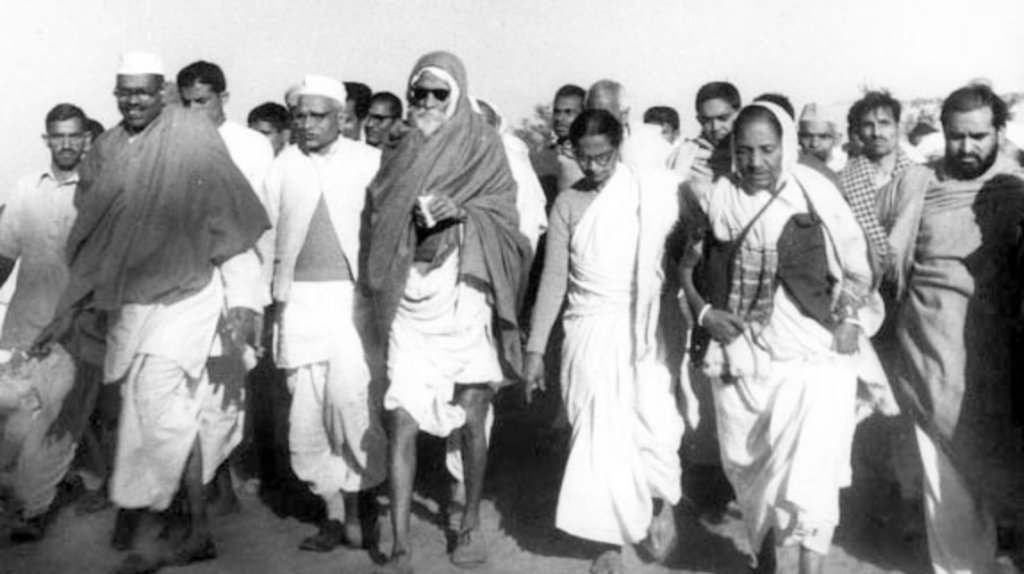While Agrarian Trust frequently leads fundraising campaigns to purchase land, a significant amount of the property held by Agrarian Commons around the country has been donated by landowners interested in securing the future of small-scale, community-supported agriculture.
The practice of donating land to the community has a rich history. In India, supporters of the Bhoodan movement, also known as the Bloodless Revolution, sought to redistribute land to peasants by direct appeals to the consciences of landowners. As US farm land is concentrated in a shrinking number of hands, the story of the Bhoodan movement’s victories and failures exemplifies the potentially revolutionary role land donors play in the equitable redistribution of land.
“Bhoodan,” is a composite of two Hindi words—bhoo and dan—and translates as “land-gift.”
In the early 1950s, Vinoba Bhave, the Indian philosopher and activist widely considered to be the intellectual heir to Mahatma Gandhi, visited the village of Pochampalli to spread the message of Ahimsa, or non-violence. The villagers born into the lowest caste gathered around him and asked for “eighty acres of land, forty wet, forty dry for forty families.” Bhave posed the question, “If it is not possible to get land from the government, is there not something villagers themselves could do?” The answer came almost immediately; a wealthy landowner stood up and announced that he would donate 100 acres of land. Inspired by the landowners act of spontaneous generosity, Bhave set out on foot to implore landowners to donate one-sixth of their land. Over the next 14 years, he would walk over 80,000 kilometers (or about 50,000 miles) in the name of the Bhoodan movement.
A wealthy landowner stood up and announced that he would donate 100 acres of land.
“Bhoodan,” is a composite of two Hindi words—bhoo and dan—and translates as “land-gift.” Drawing on Gandhi’s philosophy of Sarmadovaya, Bhave and members of the Bhoodan movement believed that land was a gift from God, and, as a result, could only be held communally. By appealing to the moral conscience of landowners to voluntarily redistribute their land to peasants, Bhave believed that land tenure in India could be transformed on the basis of communal ownership.

“Whatever land, wealth, knowledge and strength we have is from the community,” wrote Bhave. “These are not private properties, but divine properties, gifts of God, and therefore should be used for the welfare of the masses. Like the cooperation which we employ in working in a family, we should cooperatively worship nature in the same manner. We should share sorrows and happiness. We have to develop and not achieve the principles of socialism. For this, Bhoodan sacrifice is the first step because land is the biggest means for producing all types of wealth. It should be utilized jointly and cooperatively. All members of the community should have equal rights in the land.”
Land is the biggest means for producing all types of wealth. It should be utilized jointly and cooperatively.
This philosophy of communal land tenure was anticolonial to its core. The inequalities in landownership in India were rooted in a British imperial system of land tenure known as Zamindari, under which state-sanctioned landlords known as zamindars would collect taxes and govern their territory on behalf of their British rulers in return for ownership of the land. As a result, most Indian farmers had access to arable land solely on the whim of these powerful landowners. What Bhave was proposing was peasant control of the land and the empowerment of village communities.
According to historian Bimal Kumar Mandal, while the zamindari system was formally abolished when India gained independence in 1943, many zamindars continued to hold on to power. Certain factions of the Indian left, including the Indian Communist Party, responded to this delay in meaningful reform by advocating for the violent expropriation of zamindari land. Bhave, on the other hand, was a resolute proponent of Gandhi’s philosophy of nonviolent resistance, and believed that violence could not secure the universal buy-in necessary for a genuinely transformed society.
“If land donation sacrifice wants to re-distribute privately owned land, and if re-distribution is done forcibly,” wrote Bhave “then the land owner will lose his land but he will not have the heart to re-distribute the ownership. Such a revolution cannot be brought about through legislation; land reforms can be effective only through Ahimsa [non-violence] and appeal to conscience.”
Such a revolution cannot be brought about through legislation; land reforms can be effective only through Ahimsa [non-violence] and appeal to conscience.
The Bhoodan’s direct appeal to the conscience of landowners proved highly effective in the immediate term. Within two years, the Bhoodan movement secured 3.3 million acres of land. An offshoot of the Bhoodan movement, Gamdan, meaning “village-gift’,” managed to transfer 3,703 villages into communal ownership.
Still, there were significant obstacles that made it hard for the movement to fully realize Bhave’s goal of communalizing the land. First, a lack of manpower within the movement meant it was difficult to transfer land to peasant control, and much of the donated land stayed in de facto control of the original owner. Next, many landowners donated land without providing necessary legal details—such as the exact location or boundaries of the land—making it impossible for the movement to transfer it to community control. The Bhoodan movement serves as an example of the limitations of land-gifting, as well as its immense potential. On the one hand, land donations should be considered as one part of what should be a multifaceted approach, and cannot fully replace a concerted effort to influence policy and decentralize land holdings and power dynamics. On the other hand, the role of land donors should not be underestimated. Bhave and the Bhoodan movement showed that landowners are willing to make serious sacrifices in the name of a deeply moral cause.
Agrarian Trust continues to rely on land donors as it works to transform the US system of land tenure into a model based on racial justice, communal governance, and environmental sustainability. If you or someone you know owns land, please consider donating a portion of it today.


